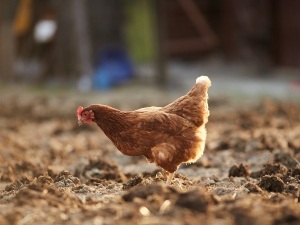
Skin inflammation, and the red color that usually comes along with it, is uncomfortable and doesn’t only affect humans. Other animals, like chickens, can suffer from skin inflammation and red skin as well.
If you’re a chicken farmer, and notice red inflamed skin on your chickens, you’re right to be worried, this article explains why this happens
If your bird develops red inflamed skin, keep an eye on its coop and how other birds interact with it. It may have mites or may be being bullied by other birds
Table of Contents
Red inflamed skin on chickens, why this happens, what to do
Being picked on during molting:
Molting is a normal process, but it can be quite uncomfortable for birds especially if there are other birds around them.
Chickens are curious animals, these birds may pick at the skin of a bird that is molting to a point where the bird starts to develop red, inflamed skin.
This picking can be quite aggressive and can be very uncomfortable to birds, but because they have evolved to not show weakness, you may notice the red inflamed skin on the bird, but the bird may show no signs of distress.
What to do:
Isolating the bird is recommended in this case. This will allow the bird to molt in peace, will keep the other birds from pecking at it, and allow the bird’s skin to calm down.
If you cannot separate the bird you can use blue-kote to keep the other birds away from it.
Bullying:
Bullying happens within different animal species, chickens included. There is a pecking order among these birds, the smaller weaker birds will fall prey to being picked on by large birds.
Once your bird starts to be picked on, and pecked by other birds, it will develop red, inflamed skin, this red skin will attract more pecking because chickens are attracted to the color red
What to do:
Using a product like blue-kote on the bird’s injuries is recommended. This liquid is not only unattractive to birds, because it is blue and not red, but it also tastes pretty bad making pecking unattractive to other birds.
This article explains how this product works in more detail.
Lice:
Parasites, like lice, will bite your chicken causing your bird to develop red inflamed skin. The bird will nervously scratch and peck themselves if they are infested with lice, making the redness and irritation worse.
Lice and mites are tiny and may not be noticed by you unless you look closely, but, just because you don’t see them doesn’t mean they aren’t there.
These parasites can usually be found around the bird’s vent or, they may be hiding in your bird’s coop. They’ll make their way onto your birds at night to feed and will hide in your bird’s coop during the day.
What to do:
If you haven’t checked yet, check the bird’s coop for lice and check the bird for lice at night.
You can use Battles Louse Powder to get rid of these tiny critters and keep your bird lice free. The redness and soreness on your bird can be calmed using Sudocrem, this is a soothing cream that can safely be used on chickens.
If your bird is pecking and scratching at the lice, you can bathe it in bicarbonate soda and water.
Poultry dust (permethrin) is also recommended, you can use this to not only treat your bird but your entire coop as well
Internal infection:
If the above reasons aren’t what’s going wrong with your bird, then the bird may be battling an internal infection. If the bird’s skin is not only red and inflamed, but is hot to the touch as well, then an infection may be the issue.
What to do:
If you suspect that your bird has an internal infection, then it is recommended that you take your bird to a vet if you can. The vet will be able to diagnose and tell you exactly what’s wrong with your bird and offer the best treatment,
Scald:
If your bird’s coop smells like ammonia, and your bird’s skin is red, inflamed, and irritated along its legs, then your bird may be suffering from scald. Hot water scalds human skin. Chicken droppings, and wet bedding, scalds chickens.
If the feces in your bird’s coop decompose too quickly it can release ammonia. This ammonia mixes with the wetness of your bird’s bedding and scalds them causing redness and irritation.
What to do:
The first thing you should do in this situation is clean out all the wet litter from your chicken coop, this will prevent the release of ammonia in the first place.
Open the chicken coop’s windows and let some fresh air in. Then lay a fresh layer of litter in the coop
FAQ:
What does dermatitis look like in chickens?
Humans aren’t the only animals who can contract dermatitis, chickens can too. In chickens, dermatitis looks dark red to purple-green.
A bird with this condition will develop gas or gelatinous fluid under the skin
The affected skin may feel spongy, as a result of the bacteria that is creating gas between the muscle and the skin
Conclusion
In conclusion, there are a variety of reasons why your birds may have red inflamed skin, this can happen as a result of their environment or the pecking order.
Your birds may also be suffering from a parasitic infection, may be molting and being picked on by other birds, may have an infection, or may have scald
If you enjoyed this article then you may also be interested in other chicken related articles. Here are some articles that you may be interested in: Baby Chick With Swollen Bottom, Red Spots On Chicken Legs, Chicken Has Dry Flaky Skin, Chicken Dandruff

